This essay traces the evolution of Galle, a coastal multi-ethnic, multi-religious city with a natural harbour in southern Sri Lanka. It has a population of around 100,000 residents (according to the 2011 census of Sri Lanka). Boxem and Fuhren, 2011, write that Galle is globally significant as an outstanding example of the interaction of European architecture and South Asian traditions of the 16th to the 19th centuries. Although its pre-colonial history is less documented and mapped, Galle has functioned as a significant shipping port since the 4th century AD. The city profile of Galle Municipal Council, prepared by UN-Habitat, highlights that the Galle port was a meeting point for Chinese and Arab traders (2006). Habarakada-Liyanage wrote in 2012: “The earliest recorded history of the town dates back to 545 AD when Cosmas Indicopleustes made reference to it in his travel journal.”
The port of Galle was the main natural marine hub on the Sri Lankan island, used by many foreign traders in pre-colonial times. Today, Galle is well known for the historic Galle Fort originally built by the Portuguese in 1588 after they landed accidentally in Sri Lanka in 1505. Its historical and natural appeal have made it one of the most popular tourist destinations in southern Sri Lanka.
The history of Galle has a long timeline, shifting from a pre-colonial trading port to a colonial military and trading hub and transforming to a post-colonial settlement, which was later endorsed as a world heritage site by UNESCO. The tension between the need for conservation of cultural heritage and the development and modernization aspirations in Galle is worth exploring. It is also important to study how people in this small town operate within the larger discourse of heritage and tourism in planning and development processes.
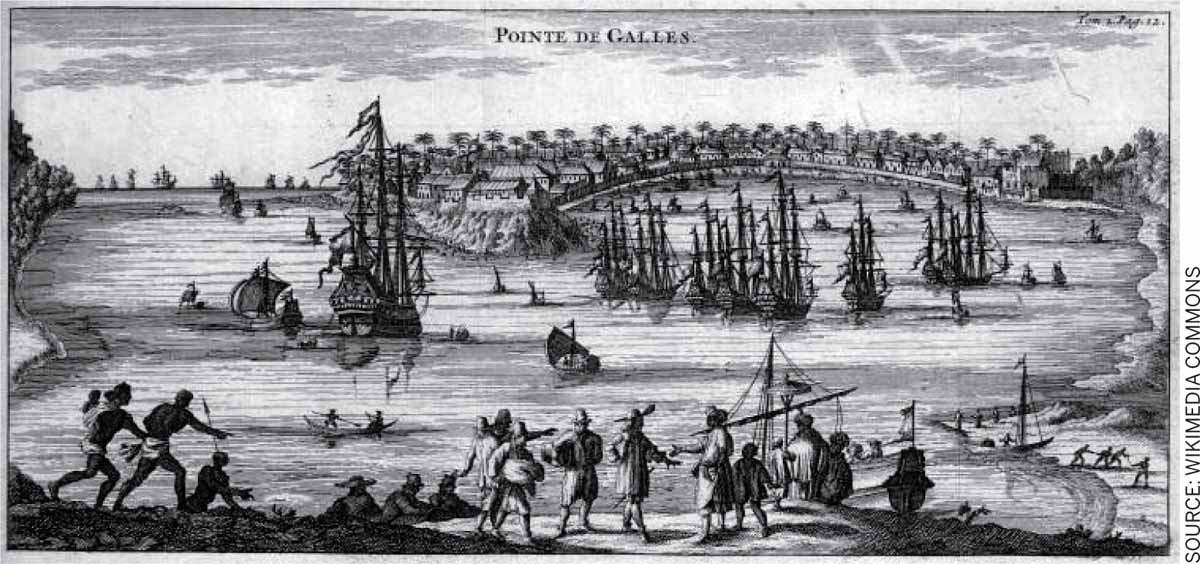
A Colonial Centre
Habarakada-Liyanage mentions that there was a larger population of Muslim traders in Galle before the Portuguese arrived. The Portuguese first settled in Galle making an agreement with the king of the Kotte kingdom to protect Galle from Muslim attacks. The Portuguese used Galle as one of their colonial centers to exercise military power and trading. They built the Fort with one wall to the north and used natural barriers in the other directions. The Portuguese used the technology they brought from Portugal along with native technology to construct the fort and the buildings, hence Galle became significantly fortified. When the Dutch captured Galle, they used the same strategic location that the Portuguese used, but rebuilt the Fort in Galle with additional protection from both land and sea by erasing most of the signs of Portuguese identity. Habarakada-Liyanage highlights that “the fierce conflicts that occurred between the Dutch and the Portuguese virtually destroyed all the Portuguese-built structures.”
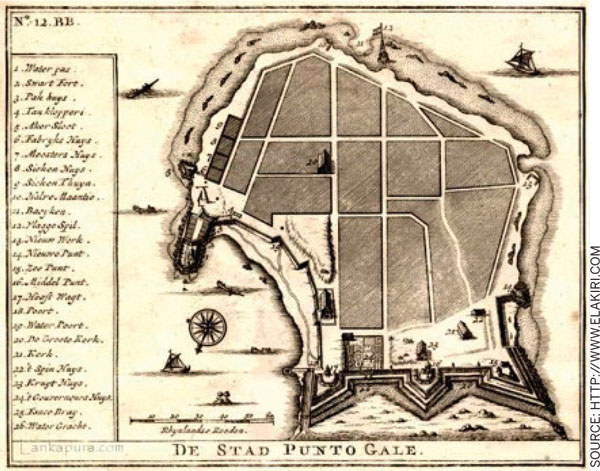 | 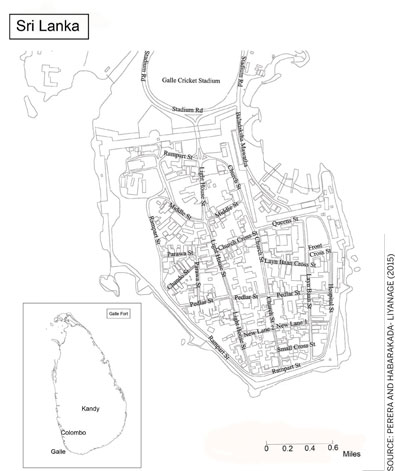 |
Today, it is rare to find Portuguese features of the built environment in Galle and most of the current built environment is considered Dutch heritage. The British captured Galle and the fort in 1796. They took over the built environment of the Dutch with some Portuguese similarities and changed the physical setting with British architecture and designs. The British used Galle as the administrative center for the south of the island. Unlike Dutch administrators, the British escorted all the non-English European descendants out from the fort. The Galle township outside the fort was occupied by locals: Sinhalese, Tamils and Muslims, and it became more diverse with the addition of European descendants.
The Portuguese laid the street network inside the Galle Fort following the existing road network and building patterns. When the Dutch took over the fort, they introduced a gridded street network, which is very colonial. The British followed the same road network, but by introducing a new entrance, they changed the function and definitions of the same space. While the British began developing colonial land uses inside the fort such as schools, churches and administrative buildings, the anti-colonial nationalistic movement began occupying the spaces outside the fort for nationalistic land uses such as Buddhist and Hindu temples, Buddhist schools and local offices for the anti-colonial movement.
Habarakada-Liyanage argues that the contemporary city of Galle and the fort are colonial products. Galle was a popular trading port in Sri Lanka.
The contemporary physical setting of Galle is highly influenced by colonial architecture and administration, yet, it is a hybrid of colonial and vernacular architecture.
It was after Independence in 1948, that the natives and people of foreign resemblance in Sri Lanka, especially the Dutch descendants, began to occupy the fort. Until Galle Fort became a world heritage site, the occupants had the freedom to ‘indigenise’ (Perera, 2015) it to match their necessities and aspirations.
World Heritage Status
The familiarization and indigenization process of the fort was frozen with the endorsement of it as a world heritage site by UNESCO in 1988. The Galle Heritage Foundation was set up to preserve the historic value of the fort by the Sri Lankan Parliament under the Galle Heritage Foundation Act. No. 7 of 1994. Most of the characteristics of the physical setting of the fort were identified as Dutch architecture for conservation purposes.
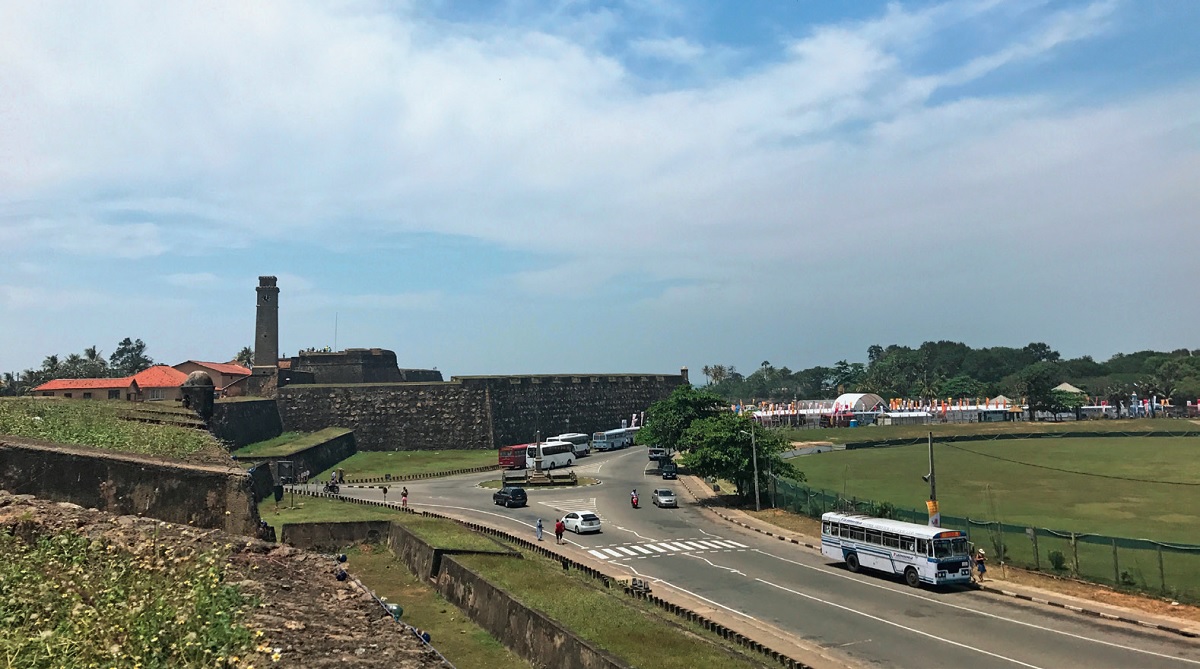
Source: Kaushalya Herath
The church, the governor’s house, the clock tower, lighthouse and most of the landmarks have the Dutch elements and the designs that were materialized with locally available materials. With the world heritage site declaration, not only was history frozen, but elements added by the locals were erased and the Dutch identity resurfaced. This effort to manipulate the authentic hybridity (Bhabha 1994) of the built environment and colonial ‘third spaces’ (Bhabha 1994; Soja 1996; Perera,2015) changed the diversity of architecture in Galle Fort.
Back in 1988, when it was declared a world heritage site and a ‘living monument’, it was a very diverse place, socially and physically. There were some Portuguese characteristics left in the built environment, although the Dutch had a huge influence in transforming the fortification and the buildings inside the fort. Dutch architecture in Sri Lanka was influenced by vernacular architecture. By the time the fort was recommended for world heritage endorsement, most of the historic buildings had a mix of Dutch and British features. Tharanga Liyana-Arachchi, Project Planning Officer for Galle Heritage Foundation, who restored 55 historical fort houses, mentioned to a local newspaper that restoration of a Dutch house on Chando Street in May 2007 was the first Galle Heritage restoration project.
This house was a late 18th century Dutch house, which the British had changed by putting in small windows and using brick columns for the facade.
Liyana-Arachchi mentioned to The Nation newspaper in 2009: “We took it back to its original Dutch state: a veranda with columns, large windows and doors and a central courtyard.” In the Sunday Leader newspaper in 2006, Ashley de Vos wrote: “The fortified port town of Galle, 90 acres in extent, with massive rampart walls, 10 bastions with pepper pot sentry points and 648 buildings, all laid out within its walls, was nominated to the World Heritage list.” After the world heritage site declaration, these buildings that were used by locals could not be amended, demolished or even altered with wall paintings as was done before the world heritage declaration.
Current Condition
Haabarakada-Liyanage found that according to available data (2012), Europeans own 60 of the 300 homes. Before 1990, there were no records of foreign ownership of properties inside the fort, but now, locals have to live in a foreign environment. There is a ‘white kids only’ preschool inside the fort. Bhagya and Chami, two graduates from the University of Moratuwa, who grew up in Galle and went to schools inside the Galle Fort, shared that although they grew up close to the fort, they feel like they’re entering a different world every time they venture into Galle Fort due to the historic buildings, building colour and designs, landscape designs, type of pavements and the number of foreigners inside. Although there are historic buildings and colonial elements outside the fort, there’s a clear spatial division between the inside and the outside. Galle is one of the largest townships in Sri Lanka and is undergoing various development projects.
It is being debated whether these development projects should consider the identity of Galle and address the spatial dynamics of colonial architecture, world heritage endorsement, changing and growing needs and aspirations of locals and familiarization process by locals in planning and implementation.
According to special regulations on development, ‘Any new constructions, improvements or renovation work of buildings that changes the internal or external appearance of a building, should be in harmony with the Conservation Development Plan.” Special regulations on development in Galle Fort have helped maintain the character of the fort. While most Dutch landscapes are very well maintained, other land uses that are privately owned by fort residents are controlled by the world heritage site regulations. Tharanga Liyana-Arachchi said to newspapers that Muslims in the fort were more concerned about their privacy, so they prefered to cover up their verandas. According to Liyana-Arachchi, project staff had negotiated with Muslim owners to preserve the character of the Dutch fort by manipulating Muslim residents’ wishes. Although there are regulations, people have found out ways to change the buildings according to their preferences and needs. Perera and Habarakada-Liyanage highlight (2015) that there are changes happening inside the fort such as overnight demolitions and constructions and changes inside the units, and that residents use bribery to get approvals for certain changes in the built environment.
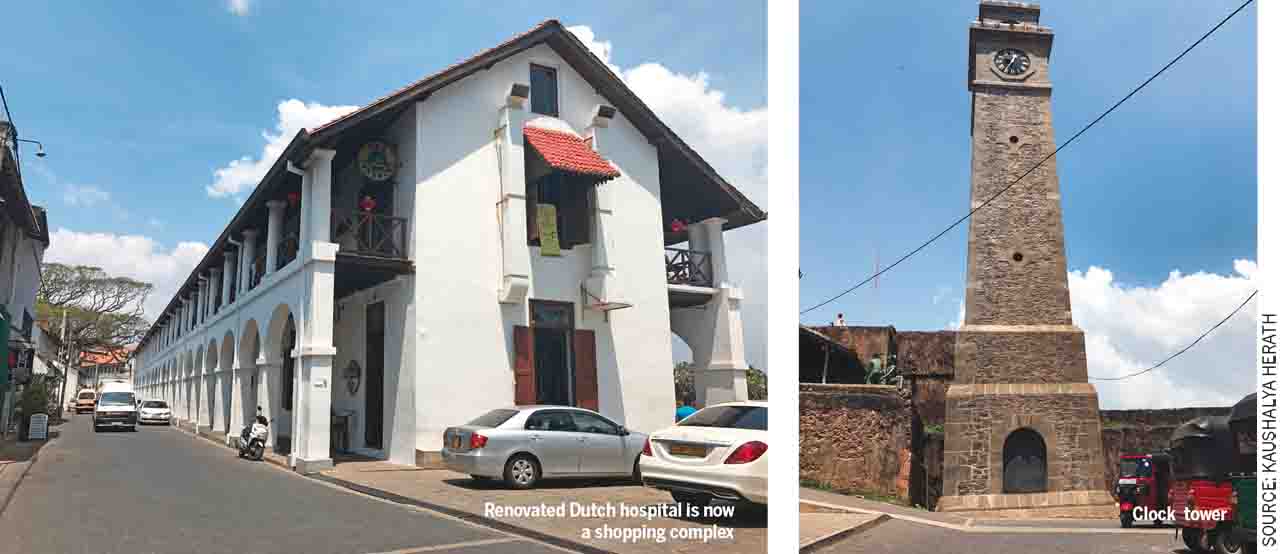
Learning from Galle
World Heritage site regulations not only froze the natural and native transformation within the fort, but they also affected the development of the entire Galle town. Most of the government administrative offices were moved out of the fort in 2005 to a newly-constructed administrative complex. This left many buildings with historical value inside the fort available to historic conservation and the tourism industry. Amenities and utilities supporting the tourism industry are emerging in the town. As the Dutch world heritage site has become the identity of Galle and world heritage projects are mostly funded by the Netherlands, the development decisions of Galle are the concern of the Netherlands. The Sunday Leader newspaper reports in 2008: “Quebec sessions held from July 2-10, 2008, sought to urge the removal of the intrusive and illegal construction within the cricket stadium, as also, to consider the abandoning, or downscaling of the current port development project to an acceptable size, considering the outstanding universal value of the property.”
 | 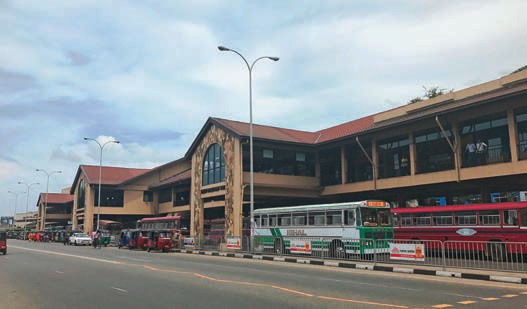 |
Elements that were considered non-essential within the historic setting of the Galle cricket stadium were abolished from the plan. Fear of being de-listed as a world heritage site has made the municipal council follow the rules and regulations strictly to preserve the character of Galle. Larger development projects in any part are requested to comply with the physical setting of the Dutch heritage. The main interest of the Sri Lankan government is to promote cultural tourism in Galle. As one of the most diverse social settings in the region, there are many aspects of Galle that are being overlooked due to mainstream and powerful colonial heritage factors. The Galle City Region Strategic Development Plan 2030, prepared by the Moratuwa University consultants in 2015, highlights that Galle is experiencing peripheral growth following the strict regulations in the Galle town center and this affects the environmentally sensitive areas around the town.
Authentic transformation of the spaces with the changing aspirations and needs of the locals has been hindered by the desire to protect the colonial heritage.
Residents have to face different social issues and they cannot achieve ever-changing needs even though some of them are benefitting from the tourism industry. Yet, as in any other urban area, Galle is not just a physical spatial unit, but a socio-spatial process where users of the spaces are continuously negotiating and transforming the space; even Galle Fort has always been naturally evolving and transforming. There have been slight transformations of society and space. Small development projects and real estate developments are happening outside the fort without being affected by heritage regulations. Tension between the development process and the historic preservation is clearly visible in Galle town, including outside the fort.
Historic preservation comes with different agendas. One argument is that historic preservation is a new form of colonisation. The government of Netherlands as the funding source for most of the restoration projects has a strong say in the development and transformation of the socio-spatial setting of Galle. The main goal of the Sri Lankan government in the world heritage designation and conservation is tourism development as mentioned in the Galle Heritage Foundation Act. No. 7 of 1994. As cited in Boxem et al, 2012, by the designation of Galle Fort as a World Heritage Site by UNESCO, the Sri Lankan government has agreed that “legislative and regulatory measures at national and local levels should assure the survival of the property and its protection against development and change that might negatively impact the outstanding universal value, or the integrity and/or authenticity of the property.” Boxem et al write that despite its international recognition, the historic center of Galle is also a living settlement, which needs to evolve in order to meet the needs of their citizens, preferably in a sustainable way and that may require development. Hence the question is how to address the changing needs of the town and its residents while protecting the cultural value of Galle.
References:
Boxem, R. & Fuhren. R. (2011). Cultural Heritage and Sustainability- The old town of Galle and its fortification as case study. Retrieved from http://robertboxem.nl/portfolio-website/Galle_as_case_study_-_English_files/download%20onderzoeksverslag.pdf
Boxem, R., Fuhren, R., Roders, A.P., Veldpaus, L., & Colenbrander, B. (2012), Assessing The Cultural Significance of World Heritage Cities: The Historic Centre of Galle as Case Study. Retrieved from http://purl.tue.nl/58494520021879
Habarakada-Liyanage. S. (2012). The Transformation of Space in The Galle Fort (Sri Lanka) by Its Inhabitants (Master’s thesis). Ball State University, Muncie, IN, USA
Perera and Habarakada-Liyanage (2015). From Resisting to Familiarizing Impositions: Living in the World Heritage Site at Galle Fort, Sri Lanka. Perera. N. (Ed.). London and New York: Routledge.

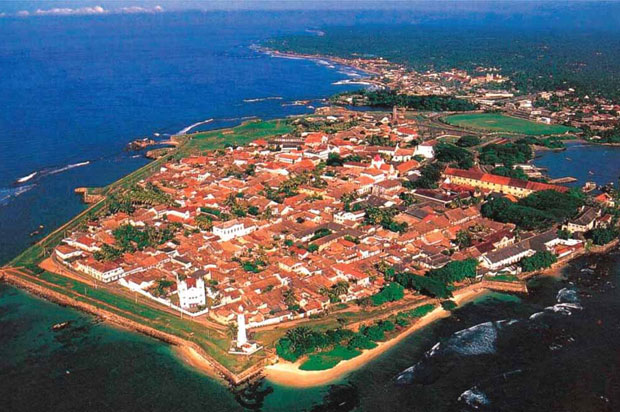

Comments (0)